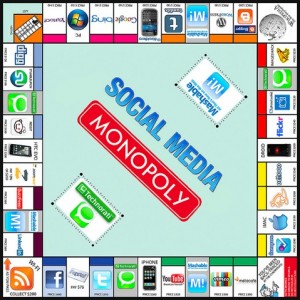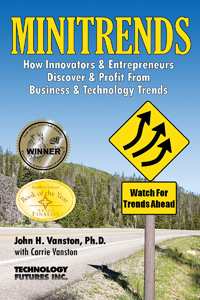“Nine Emerging Minitrends to Watch” by Dr. John H. Vanston, MINITRENDS Author & Chairman, TFI
December 28, 2010
 Happy holidays to Minitrends blog readers! We appreciate your interest in our Minitrends posts and activities. As we start the new year, there will be many opportunities for those who are alert enough to recognize emerging trends, perceptive enough to realize their importance, and clever enough to take advantage of them. Here I suggest nine Minitrends—emerging trends that will become significantly important within 2-5 years, but are not yet generally recognized—that are well worth examining for possible action by those ambitious individuals who seek to start new ventures or keep existing businesses innovative and competitive.
Happy holidays to Minitrends blog readers! We appreciate your interest in our Minitrends posts and activities. As we start the new year, there will be many opportunities for those who are alert enough to recognize emerging trends, perceptive enough to realize their importance, and clever enough to take advantage of them. Here I suggest nine Minitrends—emerging trends that will become significantly important within 2-5 years, but are not yet generally recognized—that are well worth examining for possible action by those ambitious individuals who seek to start new ventures or keep existing businesses innovative and competitive.
Unlike megatrends, Minitrends are of a scope and importance to offer attractive opportunities to individual entrepreneurs, decision-makers in small and mid-size businesses, innovative thinkers in large companies, and adventuresome investors. In my new book, MINITRENDS: How Innovators & Entrepreneurs & Discover & Profit From Business & Technology Trends, I categorize the nine Minitrends below to those most applicable to different-sized groups. (In the book, I also discuss the background, current trends, and business opportunities of each of these Minitrends in more depth.) I do the same categorization below, but in reality, all provide opportunities to perceptive individuals in all-sized businesses.
Minitrends Particularly Applicable to Individuals or Small Groups of Individuals:
1. Expanding Involvement in Virtual Worlds (Free Virtual Worlds book excerpt available):
Virtual worlds are computer-based platforms that allow participants to engage in a wide range of real-world type activities, e.g., buying and building virtual world property, furnishing virtual world homes and offices, producing and selling virtual world goods, traveling, taking part in virtual world social activities such as parties and fundraisers, and communicating with other participants. Increasingly, virtual worlds are being used for educational purposes, product advertisements, new product modeling and testing, identification of new markets, and uncovering unexpected problems with new marketing programs.
2. Support for People Working at Home:
Although an increasing number of people are now conducting all or part of their work at home, these people often find they miss interacting with others and miss the convenience of facilities, equipment, and administrative support. A number of solutions are emerging to better meet the needs and desires of people working at home, including small offices or meeting rooms that can be rented by the day or the hour; chat rooms where people can meet informally to discuss ideas; semiformal groups that meet regularly to establish person-to-person interactions; and temporary support staffs organized to provide administrative assistance as needed.
3. Expanding Capabilities of Advanced Websites:
Although the World Wide Web had proven to be extremely popular, many believed a more interactive platform that took advantage of the Web’s power to communicate would be desirable (Web 2.0). Programmers are now expanding the capabilities of the Web to substitute computer activities for human activities, particularly activities that are repetitive, burdensome, and uninteresting (Web 3.0). Many believe Web 3.0 will eventually lead to effective artificial intelligence that can interact with humans in natural language.
Minitrends Particularly Applicable to Small and Medium-Size Companies:
4. Increasing Interest in Privacy:
Recent advances in technology, together with an increasing willingness of many to make personal information more easily available are threatening traditional concepts of privacy in terms of messaging, personal profiles, and identity. Techniques for countering these invasions of privacy, such as personal caution, technology aids, and group action are now being developed.
5. New Approaches to Giving and Receiving Advice:
Individuals and organizations commonly seek expert advice when making important decisions. In providing such advice, large consulting firms with large, multidisciplinary staffs, well-structured processes and procedures, huge computer capabilities, and long-standing reputations have traditionally had a major advantage. However, the ever-increasing power and ubiquity of information gathering, processing, and communicating technologies, small and medium-size consulting groups are often able to give more focused, timely, and user-friendly advice than the larger firms.
6. Evolution of Meaningful Maturity:
The twin trends of increasing life spans and decreasing retirement ages have caused a steady increase in retirement years. Because of social, personal interest, and/or financial reasons, many older individuals are either staying in their jobs longer or returning to the workforce. Their ability to utilize their experience, skills, and dedication effectively will depend on their current capabilities, their desires, and open opportunities to those willing to assist them.
Minitrends Particularly Applicable to Large Companies:
7. Advances in Digital Manufacturing:
Advanced digital manufacturing (ADM) processes build complex, custom-made parts by the addition of successive layers of material rather than traditional machining processes that cut, bend, and machine a part from stock material. The processes allow quicker production of prototypes and small production runs at a much lower cost. Recent ADM advances, including improved yield rates, reduced time-to-market, increasing variety of materials, and advances in 3D modeling software, have made ADM processes increasingly attractive to many manufacturers.
8. Increasing Electricity Use in Manufacturing:
The characteristics of electric power, such as high power density, no heat transfer medium requirements, controlled energy distribution, reduced material waste, and less environmental impacts, provide a number of benefits to manufacturing processes. Its use, however, has been limited by its relatively high cost. A number of factors, including advances in control technologies, changing customer needs, global competition, and increasing concern about the environment, are driving an increasing growth in the use of electricity in industrial processes.
9. New Applications of Nanotechnology:
When many substances are reduced to nano-size (100 nanometers or less) they often exhibit very different physical, electrical, chemical, and optical properties from the same substance at macro-size. These new properties often provide very unique and useful characteristics to nano-materials that can be used in a wide range of practical applications, such as cancer treatment, very high strength materials, special electronic systems, and water purification. Improved production techniques, decreased costs, and growing experience and understanding are increasing the practical applications of nanotechnologies
Minitrend involvement can give you a way to separate yourself from your colleagues and contemporaries. It provides a means for materially improving your business situation, your financial standing, and your personal satisfaction. I hope the Minitrends listed above will assist you or inspire you to launch your own exciting, profitable Minitrend Adventure that allows you to utilize your imagination, your logic, your innovative nature, and your basic good sense in the coming year.
Copyright 2011. Please feel free to reprint this article in whole or part with due credit to: “by Dr. John H. Vanston, MINITRENDS Author and Chairman, Technology Futures, Inc.” Thanks!
How Large Organizations Foster Innovation
December 14, 2010

An expansive new study just released by the Network for Business Sustainability provides valuable suggestions for executives in large organizations about how to keep their companies innovative and competitive.
The report, “Embedding Sustainability in Organizational Culture,” involved reviewing over 13,000 academic and industrial studies, then narrowing these down to 179 primary sources which were synthesized to extract common principles and best practices.
The issue of how to spur creativity in large organizations was a driving motivation for the new book, MINITRENDS. Author John H. Vanston, Ph.D., a nuclear engineer, university professor, and chairman of the technology forecasting firm, Technology Futures, Inc., is often called upon by large businesses to help them predict the future. These big companies want to ride technology trends, not be run over by them.
It’s one thing to know what’s coming, and another to be able to adjust to it. The new report from the Network for Business Sustainability is chock-full of ideas for keeping large organizations from getting stuck. It contains both the principles of innovation and copious examples of clever ways big companies have found to stay nimble. Here are some suggestions culled from the 74-page report:
- Remove barriers to teamwork and collaboration through the abolition of separate dining rooms for managers and line employees.
- Support an innovation culture through small gestures of recognition. At Bank of America, a small pin presented by high-level management “gave encouragement to employees who enacted the organization’s values and refocused management styles toward promoting and supporting these values.”
- The Ethical Corporation begins every meeting with a quick success story. Storytelling is used to create the “true believers and adherents” essential for embedding innovation. These stories help teach team members new ways of thinking and doing things.
- Include employees in developing team mission statements. This helps employees “build a sense of collective ownership, commitment, and focus and, through this, a culture of innovation.”
- Engage suppliers, customers, and even community representatives in dialogue about innovation. “Organizations must consider the entire supply chain and process, where suppliers and vendors are seen as partners co-designing and co-creating ideas and sustainability innovations.”
- Senior management must nurture feedback channels to “create a safe place for bold ideas to emerge.” The authors suggest that it is not enough to provide a feedback mechanism, but that senior management must actively solicit feedback through those channels and hold regularly-scheduled meetings to review suggestions.
- Innovation challenges, involving deadlines, recognition, and financial rewards, have been effective spurring innovation in many companies.
The study was written by Stephanie Bertels, PhD., an assistant professor at Simon Fraser University. She has made the results available, at no charge, in two different formats:
- A Systematic Review of the Body of Knowledge ( 74-page PDF)
- A How-To Guide for Executives (20-page PDF)
For those companies wishing to remain innovative, and for chief executives concerned about the future of their organizations when they leave, I would also recommend the book, MINITRENDS. If we have focused on entrepreneurs and small businesses here on this blog, that’s because innovation in large organizations often is the result of employees cultivating an entrepreneurial mindset and the organization acting like a venture capitalist in support of those individual efforts.
Fully one-third of MINITRENDS is devoted to fostering creativity in large organizations. The book is inspiring to individual employees and provides them with a set of skills for identifying and qualifying trends that show promise for profitable development in the near future. It should be required reading in organizations that hope to outlive their founders.
STEVE O’KEEFE
News Editor, Minitrends Blog
Source: “Embedding Sustainability in Organizational Culture” (PDF), Network for Business Sustainability, December 2010
Image courtesy of the Network for Business Sustainabilty, used under Fair Use: Reporting.
A Longer Lifespan with Science and Work
December 10, 2010
 Since I was born, average life expectancy in the U.S. has increased by 10 years, from about 68 years to 78 years. In the next decade, it will increase by another 20 years, according to futurist Ray Kurzweil, who predicts that by the year 2019, the life expectancy of someone born in the U.S. will be over 100 years.
Since I was born, average life expectancy in the U.S. has increased by 10 years, from about 68 years to 78 years. In the next decade, it will increase by another 20 years, according to futurist Ray Kurzweil, who predicts that by the year 2019, the life expectancy of someone born in the U.S. will be over 100 years.
A celebrated M.I.T. scientist, Kurzweil has embarked upon a dietary regimen designed to improve his longevity to the point where “life expectancy is no longer a viable term in relation to intelligent beings.” Until recently, the dominant method of life extension has been calorie restriction. If you can cut your daily calories in half without impacting your vitality, studies show you will live considerably longer.
Last week, another breakthrough offered hope for an engineered end to aging. The forever elusive “fountain of youth” is now pumping out telomerase. Telomerase is an enzyme that keeps telomeres from unravelling. Ewen Calloway, a biotech writer for the journal Nature, which published this new Harvard study, explains the significance of telomeres:
Chromosomes have caps of repetitive DNA called telomeres at their ends. Every time cells divide, their telomeres shorten, which eventually prompts them to stop dividing and die. Telomerase prevents this decline in some kinds of cells, including stem cells, by lengthening telomeres…
In the Harvard study conducted by the Dana-Farber Cancer Institute and Harvard Medical School, mice were genetically engineered with dormant telomerase, resulting in their rapid and premature aging. Feeding the mice a chemical called 4-OHT reactivated telomerase production, and the mice were remarkably restored to a normal age.
There is hope that telomerase could be used to stimulate the growth of neurons, restoring vitality to the worn-out brains and other organs. However, there’s a catch. Tiffany Kaiser at DailyTech delivers the bad news:
While this therapy is ideal for mice, it will be challenging to translate this type of treatment to humans because slowing the aging process this way could increase the risk of cancer in humans. Mice have the ability to create telomerase throughout the span of their lives, but telomerase eventually discontinues in humans in order to stop cells from overpopulating and possibly turning into cancerous cells.
The promise of the Harvard study is that it shows a reverse in aging, not just a halt to aging. The problem is that it did not extend the lives of the mice one bit; it merely returned them to a normal longevity. Kyle Munkittrick at Discover is also skeptical of the translation of this breakthrough to humans:
It still remains to be seen if telomerase treatments can delay normal aging, reverse normal aging, or extend life in any way in mice. From there scientists have to then figure out what side-effects there are, why those side-effects occur, and then somehow translate the results to human beings. [Emphasis his.]
Perhaps telomerase is not the wonder drug that will keep us alive indefinitely. But something is working to expand our life expectancy, and it might be work. In their new book, MINITRENDS, futurist John H. Vanston and his daughter, Carrie Vanston, note with some surprise that the one trait that links successful entrepreneurs is “exceptionally good health.” Which begs the question, which came first, the health or the work?
Jeannine Stein reports for the Los Angeles Times on a study funded by the National Institute on Aging into the effects of employment on the health of retirees:
The researchers coined the term ‘bridge employment’ to describe the transition period between full-time work and full-time retirement, in which people work part time, are self-employed or temporarily employed. Men and women in that bridge employment category reported fewer major diseases and functional limitations compared with those who were in full retirement.
John and Carrie Vanston devote a significant portion of MINITRENDS to exploring the business opportunities for entrepreneurs resulting from life extension. For some employers, it simply means a larger pool of relatively low-cost, experienced workers. Will other countries be insourcing their busy work to our senior citizens?
The Vanstons also see business opportunities in retooling older workers with modern skills. Already, many retirement homes are locating near universities or on college campuses, to give seniors ready access to both the classes and the culture available from the publicly-funded centers of learning.
As many of us face the prospects of living to be 100 years old, it is comforting to know that those later years can be profitably and pleasurably employed providing valuable services to others. Science will continue to improve our ability to work in our later years, and the exciting work of entrepreneurship will continue to keep us young!
STEVE O’KEEFE
News Editor, Minitrends Blog
Source: The Age of Spiritual Machines, by Ray Kurzweil, pp. 208, 280
Source: “Telomerase reverses ageing process,” Nature, 11/28/10
Source: “Harvard Scientists Reverse Signs of Aging in Mice,” DailyTech, 11/29/10
Source: “Another Tiny, Exciting Step Toward Life-Extension,” Discover, 11/29/10
Source: “Considering retirement? Working might keep you healthier,” Los Angeles Times, 11/14/10
Photo by be_khe (Giang Ho Thi Hoàng), used under its Creative Commons license.
Denial of Service Attacks Spread in Web’s First InfoWar
December 9, 2010
 Nearly 20 years ago, when promoting a book called Secrets of a Super Hacker by an author named “The Knightmare,” I got a wake-up call about how vulnerable the Internet was. This week, many companies have learned how vulnerable they are after being shut down by hackers related to the WikiLeaks drama.
Nearly 20 years ago, when promoting a book called Secrets of a Super Hacker by an author named “The Knightmare,” I got a wake-up call about how vulnerable the Internet was. This week, many companies have learned how vulnerable they are after being shut down by hackers related to the WikiLeaks drama.
Yesterday, MasterCard’s website was shut down for hours by a group of hackers angry that the credit card company had ceased processing payments to WikiLeaks. Andy Greenberg has been following this story minute-by-minute on The Firewall, his computer security column for Forbes:
MasterCard, which cut off services to WikiLeaks Tuesday, became the latest victim of a loose group of hackers known as Operation: Payback Wednesday morning, when its website went down under a flood of junk traffic sent by the group’s volunteer army… PayPal has already come under two cyberattacks after its decision to cut off its services to WikiLeaks last Friday night… And now PayPal may be back on its target list, followed by Twitter.
The technique being used in these attacks is a “Distributed Denial of Service” attack, or DDoS. The idea is to temporarily take control of thousands of computers on the Internet and direct them to a single Web address, causing the site to falter and eventually shut down. This technique was used by a hacker named “Jester” to shut down WikiLeaks in November. It’s the same technique being used by “Operation: Payback” and a group of hackers named “Anonymous” (a.k.a. “4Chan”) to retaliate against companies such as Amazon, PayPal, Visa, and others who have severed support services to WikiLeaks.
If you’re wondering what it’s like enduring a DDoS attack, Bill Brenner, the information security expert for CSO Magazine, provides a minute-by-minute account of the July 4, 2009, cyberattack that took out the Federal Trade Commission’s website, along with the Department of Transportation, and many private companies:
In that onslaught, a botnet of some 180,000 hijacked computers hammered U.S. government websites and caused headaches for businesses here and in South Korea.
This is the infamous attack that caused Google to publicly blame Chinese hackers, leading Google to eventually move its servers out of mainland China. By way of comparison, the attack on WikiLeaks last week was estimated at nine times larger than the infamous Fourth of July attack. Ironically, one of the 250,000 diplomatic cables recently released by WikiLeaks implicates the Chinese government in the Fourth of July attacks.
In a tweet on December 3 related to the WikiLeaks hackathon, Electronic Frontier Foundation co-founder John Perry Barlow uttered the syllables many a CIO has feared: “The first serious infowar is now engaged.” Barlow was one of the experts I approached in 1993 to review the book, Secrets of a Super Hacker.
The promotion for that book included a contest offering a prize to the first person who could hack my email account and send an email from my own account claiming the prize. When I first proposed the contest, the publisher’s Internet Service Provider (ISP) immediately notified all their subscribers, resulting in such an outcry that we decided to move the contest. Next, I approached The WELL, the cybercommunity in San Francisco where Barlow and many now famous members of the digerati hung out.
The WELL wanted no part of our contest, either, and threatened to suspend our account if we tried to run it there. I thought they would be pleased to have this benign test of their security systems. Instead, The WELL and several other ISPs I approached wanted no part of our hacking contest. Why?
After discussing the situation with several ISP administrators, I realized that security was not a priority for many of them. Most of them were using whatever weak protection came standard with the software they bought. They did not want their systems tested. If they had any extra money, they spent it on marketing: sprucing up the front door, not patching up the back door.
Our little contest served as a wake-up call for several service providers at the dawn of the Internet era. The infowar between WikiLeaks’ opponents and defenders should act as a loud wake-up call to online organizations everywhere to check their defenses. Cyber warfare has come of age, and the stakes now are higher than anyone imagined.
STEVE O’KEEFE
News Editor, Minitrends Blog
Source: “MasterCard Taken Down By WikiLeaks Supporters, Twitter Next?,” Forbes, 12/08/10
Source: “What it’s like to get hit with a DDoS attack,” CSO Magazine, 12/08/10
Source: JPBarlow on Twitter
Image: Book cover of Secrets of a Super Hacker is used under Fair Use: Reporting.
IDC Sees Perfect Storm in Portable Computing
December 8, 2010

On December 2, International Data Corporation (IDC), the giant IT research firm out of Framingham, Massachusetts, released its annual predictions for IT in the coming year. The firm is forecasting a perfect storm for IT: a combination of cloud computing, mobile computing, and social networking that threatens to consign desktop PCs to the storage closet.
The author of the survey is IDC’s chief analyst, Frank Gens, who leads IDC’s 1,000 analysts in 110 countries in tracking IT trends. Summarizing this year’s report, Gens sees a nearly complete transformation in the dominant computing platform:
What really distinguishes the year ahead is that these disruptive technologies are finally being integrated with each other — cloud with mobile, mobile with social networking, social networking with ‘big data’ and real-time analytics. As a result, these once-emerging technologies can no longer be invested in, or managed, as sandbox efforts around the edges of the market. Instead, they are rapidly becoming the market itself and must be addressed accordingly.
As the IDC report ripples through the Internet, different players are examining what it means for the future of computing. At ComputerWorld, Sharon Gaudin comments on the surge in social networking, suggesting that business startups will stop building expensive and complicated websites and opt for free Facebook pages instead.
Anuradha Shukla at TechWorld is enthusiastic about IDC’s upbeat predictions for IT expenditures. The report forecasts a 5.7% increase in outlays over 2010, to $1.6 trillion worldwide. IDC sees half of that spending coming from emerging market countries shrugging off the recession.
At PC World, Patrick Thibodeau focuses on IDC’s prediction that shipments of apps-enabled mobile devices — smartphones and tablets — will surpass shipments of PCs in the next 18 months. Thibodeau points out, however, that shipments of PCs are not declining; rather, they are growing, but not nearly as quickly as mobile devices.
Another prediction that is sure to catch the eye of venture capital firms: Gens says that nearly a third of the major players in social networking will be bought up in the coming year by the likes of Oracle, Microsoft, HP, and IBM, who need to get in the game.
While many others futurists we have covered on the Minitrends blog have made similar predictions about the growth in cloud computing, mobile computing, and social networking, none of them have joined them together with such a powerful vision of a whole new way of working that Frank Gens brings to IDC’s report.
What do you think is coming in 2011? Do you think it will be just more of the same, or the beginning of a totally new platform, as the IDC report speculates? We welcome your comments.
STEVE O’KEEFE
News Editor, Minitrends Blog
Source: “IDC Predicts Cloud Services, Mobile Computing, and Social Networking to Mature and Coalesce in 2011, Creating a New Mainstream for the IT Industry,” IDC Press Release, 12/02/10
Source: “Business will get more social in 2011, IDC says,” ComputerWorld, 12/06/10
Source: “Cloud services, mobile computing and social networking to mature in IT industry,” TechWorld, 12/07/10
Source: “In historic shift, smartphones, tablets to overtake PCs,” PC World, 12/07/10
Photo by davedehetre (David DeHetre), used under its Creative Commons license.
What’s On TV? Amazon, Netflix, Apple, Google…
December 7, 2010
 Last week, we wrote about the growing trend of consumers “cutting the cord” and switching from watching broadcast or cable television to watching streaming TV through the Internet from the likes of Netflix and Hulu. This week, things are getting ugly. Broadcast and cable companies are fighting back while Amazon and other competitors prepare to enter the couch-potato war.
Last week, we wrote about the growing trend of consumers “cutting the cord” and switching from watching broadcast or cable television to watching streaming TV through the Internet from the likes of Netflix and Hulu. This week, things are getting ugly. Broadcast and cable companies are fighting back while Amazon and other competitors prepare to enter the couch-potato war.
Let’s start with what some are calling “The Death of Net Neutrality.” At the end of November, Comcast looked at the amount of Netflix data it was sending to Comcast subscribers and decided it wasn’t being paid enough to handle it. Comcast insisted on a surcharge from Level 3, a company that processes Netflix streams.
Level 3 cried “foul,” and squealed about the surcharge to all who would listen, including the feds, who are currently evaluating Comcast’s proposed takeover of NBC Universal. Comcast then issued a “wait just one minute” statement telling its side of the story. Both Level 3’s punch and Comcast’s counterpunch are covered crisply by Mark Huffman at ConsumerAffairs.com. Within days, Level 3 issued a “clarification” of its position. An apology? No! A rebuttal of Comcast and a repeat that this is a stickup on the information superhighway.
For the lowdown on this shakedown, you couldn’t ask for a better guide than Scott Woolly, who covered technology for Forbes before becoming a contributing editor at Fortune. Covering the fracas for M.I.T. Technology Review, Woolly says:
The history of fights between big networks indicates that one of two things will soon happen in the Comcast-Level 3 fight. Either the two companies will privately settle their differences, or they will start an all-out war that balkanizes the Internet — what is known in the trade as ‘depeering.’
But the Comcast surcharge means little to Netflix compared to the bomb dropped in Monday’s Wall Street Journal, where reporters Nick Wingfield and Sam Schechner came out of nowhere with this scoop:
Amazon.com Inc. is developing a Netflix-like subscription service that would offer TV shows and movies, according to people familiar with the matter.
This comes just two weeks after Netflix moved onto Amazon’s cloud, which is a little roomier now that Amazon has booted WikiLeaks off the cloud. And if that isn’t bad enough, over the weekend, Google purchased Netflix supplier Widevine, a digital video management company. Widevine optimizes the streaming of Netflix videos over the Internet. The acquisition will help Google TV in its battle against Apple TV, Netflix, and, coming soon, Amazon TV.
Just when you thought it was safe to cut the cord, you look around and realize everyone has a knife in this fight. Right now, most of them are pointed at Netflix.
STEVE O’KEEFE
News Editor, Minitrends Blog
Source: “Netflix Supplier Complains About Comcast Fees,” ConsumerAffairs.com, 11/30/10
Source: “Level 3 ‘Clarifies’ Position On Comcast Fees,” ConsumerAffairs.com, 12/06/10
Source: “Peer Pressures Could Strain the Web,” M.I.T. Technology Review, 12/06/10
Source: “No Longer Tiny, Netflix Gets Respect — and Creates Fear,” The Wall Street Journal, 12/06/10
Source: “Google buys Widevine to beef up DRM offering,” Fortune, 12/06/10
Photo by Mark Robinson (me’nthedogs), used under its Creative Commons license.
Technology Trends for Entrepreneurs
December 6, 2010

Android-operated microwave oven, from Touch Revolution video.
Entrepreneurs don’t only create new technology trends, they also use them to take care of businesses. One example is the trend away from using in-house journalists to using freelance journalists to using custom content farms.
An example of an entrepreneur who has successfully mined the Minitrend of content farming is Jonathan Blum. Blum has shifted from a career in broadcast journalism, where he worked for MTV and covered the O.J. Simpson trial for ABC News, among other accomplishments, to a career in custom journalism through his award-winning startup, Blumsday.
Blumsday provides custom content for high-end clients, including CNN and TheStreet. His articles are regularly featured in Entrepreneur magazine. His work earned a Best in Business Award from the Society of American Business Editors and Writers.
One of Blum’s recent creations for Business Insider is a list of the top tech trends for entrepreneurs or, as he puts it,
[…] the top 25 tech tips, trends and megatrends: what’s new now, what will be new tomorrow and what you can expect to grapple with even farther down the road.
I would argue that most of these are “minitrends” rather than “megatrends” — that is, trends that show the likelihood of widespread adoption in the next two to five years and are the byproduct of such megatrends as the spread of the Internet, the growth of mobile devices, or the need for alternative energy sources.
The first minitrend I notice is the increasing use of slideshows instead of text to render the forecasts of pundits. Last week, we reviewed the top 10 tech trends of veteran computer journalist Eric Lundquist, who also presented his picks in slideshow format. We also covered Verizon’s top tech trends, which were presented with video — another Minitrend we expect to see more of in the coming years.
Many of the trends on Blum’s list will already be familiar to readers of this blog. Some of the less typical ones include:
- Touch Kiosks — Blum suggests that using inexpensive touchscreens from companies such as HP and Acer can save a bundle in self-serve customer service.
- Server Simplicity — New products combine “phone servers, e-mail servers, routers, document servers and firewalls into a single low-cost device.”
- Smart Boards for Smarter Presentations — BoxLight and Epson make portable smart boards that take presentations way past the PowerPoint.
- Apps for Your Apps — New apps that run on your household appliances, such as washers and dryers, TVs and microwave ovens. No fooling. Check out the Engadget review.
- Automatic Decision-Making — As computers get smarter, they can do more of our work for us. Entrepreneurs look forward to the day when they can ask the computer to find the 20 best venture capital prospects for a business, then return after a coffee break to find a quality list waiting. Blum points to Google’s Aardvark as an early example of an intelligent assistant.
- Virtual Assistant — Using a bot to represent you at meetings, recording what happens and answering questions by accessing all your computer files, may be more than five years away, but it’s still fun to ponder.
Blum has lots of other tips in his presentation — especially for the eco-conscious entrepreneur interested in energy-saving technologies. I recommend you take his presentation for a ride. It’s a quick trip that really delivers do-it-now ideas for entrepreneurs on the go.
STEVE O’KEEFE
News Editor, Minitrends Blog
Source: “The Future-Proof Entrepreneur: 25 New Tech Trends You Need To Know About,” Business Insider, 11/14/10
Source: Blumsday, undated
Image: Screen capture from Touch Revolution video presentation, used under Fair Use: Reporting.
FTC Advocates Do-Not-Track; Advertisers Upset
December 3, 2010

Screen capture from the Interactive Advertising Bureau's "AboutAds.info" opt-out page. To install the IAB's opt-out software, users must expose their browser to significant privacy risks by enabling cookies.
On December 1, the U.S. Federal Trade Commission presented a preliminary report (PDF) outlining a “framework for privacy” that endorses a “Do-Not-Track” option for Web browsers similar to the agency’s popular “Do-Not-Call” service for telephones.
Unlike the Do-Not-Call program, which creates one central place where individuals can easily add their phone numbers to the list, with reprisals for companies that violate their preferences, the Do-Not-Track mechanism (“DNT”) will be built into the Web-browsing software and other applications used to access the Internet from computers, tablets, and smartphones. Each piece of software or app would have to include a DNT feature. Currently, there are no proposed guidelines for consistently implementing that feature, nor any real authority to enforce it.
Forbes‘ new privacy blogger, Kashmir Hill, says, “At the end of the day, this report isn’t going to change anything.” Kevin Fogarty, the highly opinionated blogger for ITworld‘s “CoreIT” blog, is blunt in his assessment, calling the FTC report:
[…] a set of recommendations with roughly the same clarity, credibility and impact of a strongly worded letter from the U.N. to this year’s evil dictator asking him to please not kill and eat so many villagers.
At The Huffington Post, consumer rights activist Jamie Court threatens a privacy initiative in California: “If Congress doesn’t act, we will go to the ballot.”
While Internet giants, including Google and Microsoft, have learned to tame their public pronouncements and pay lip service to the FTC’s recommendations, they let the trade groups they fund do the barking for them. Mike Zaneis, senior vice president and general counsel of the Interactive Advertising Bureau (IAB), is quoted by The New York Times media reporters Edward Wyatt and Tanzina Vega as saying that the DNT mechanism will cause “significant economic harm” if it has “a high participation rate similar to that of do not call.”
The IAB is recommending voluntary measures where sites place prominent “opt-out” buttons that disable tracking, rather than a central registry or browser build-ins. The organization touts its AboutAds.info site, where you can opt out of being tracked by a very small group of sites that participate.
John and Carrie Vanston devote a major section of their new book, MINITRENDS, to business opportunities arising from increasing interest in privacy. They predict that the U.S. will strengthen its privacy laws, opening up profitable new business lines for entrepreneurs:
The federal government of the United States has adopted only limited formal legislation to protect privacy compared to Canada and most European countries.
Among the businesses that will profit from strengthening privacy laws are software developers, training firms, and the new field of online reputation management companies.
Certainly, someone needs to come up with a solution better than the IAB’s “opt-out” site. When this reporter visited the site to test the opt-out features, I was advised I would have to enable cookies in order to install the software (see screen capture, above). While enabling cookies would protect me from being tracked by few dozen sites participating in the IAB’s program, it would open me to tracking by the millions of sites that not only don’t participate, but sometimes use methods that are much more intrusive than those of IAB’s supporters — methods which remain, unfortunately, virtually unregulated.
STEVE O’KEEFE
News Editor, Minitrends Blog
Source: “Protecting Consumer Privacy in an Era of Rapid Change” (PDF), Federal Trade Commission, 12/10
Source: “Brief Takeaways — and a Pretty Diagram — from the FTC’s Online Privacy Recommendations,” Forbes, 12/01/10
Source: “FTC becomes aware there is an Internet,” ITworld CoreIT Blog, 11/17/10
Source: “Will We Get a ‘Do Not Track Me’ List for Our Personal Information Online?” The Huffington Post, 12/01/10
Source: “F.T.C. Backs Plan to Honor Privacy of Online Users,” The New York Times, 12/01/10
Source: MINITRENDS How Innovators & Entrepreneurs Discover & Profit From Business & Technology Trends, p. 97.
Image from AboutAds.info, the Interactive Advertising Bureau’s “opt-out” site, screen capture recorded 12/02/10. Used under Fair Use: Commentary.
Is Google a Monopoly? EC Launches Investigation
December 2, 2010
 We monitor technology trends on this blog. One of the biggest tech trends of late is accusing Google of having a monopoly, or monopolies (plural), which begs the question of what, exactly, Google has a monopoly over? Most of the accusations center around search.
We monitor technology trends on this blog. One of the biggest tech trends of late is accusing Google of having a monopoly, or monopolies (plural), which begs the question of what, exactly, Google has a monopoly over? Most of the accusations center around search.
“Google ‘owns’ search,” says Columbia Law Professor, Tim Wu, in a November 13 piece for The Wall Street Journal‘s WSJ “Review” section. Wu’s new book, The Master Switch, is sounding the “Google as monopoly” bell which rang loudly before the U.S. Presidential elections in 2008 but has quieted down since.
Wu’s definition of “ownership” is quite a bit looser than a pure monopoly. Google “owns” less than two-thirds of the search market, according to ComScore. In June of this year, Google held 62.6% of search queries; Yahoo held 18.9%; and Microsoft’s Bing has grown to an impressive 12.7%. Having a dominant position in a field with few barriers to entry is not a monopoly. Just ask MySpace.
Two days ago, however, the accusations that Google has a monopoly moved from the rhetoric to real threat as the European Commission opened an investigation into whether Google has abused its position as the dominant search engine by intentionally skewing search results to benefit entities it owns. From the EC’s press release announcing inquiry launch:
The Commission will investigate whether Google has abused a dominant market position in online search by allegedly lowering the ranking of unpaid search results of competing services which are specialised in providing users with specific online content such as price comparisons (so-called vertical search services) and by according preferential placement to the results of its own vertical search services in order to shut out competing services. The Commission will also look into allegations that Google lowered the ‘Quality Score’ for sponsored links of competing vertical search services. The Quality Score is one of the factors that determine the price paid to Google by advertisers.
The argument here is not that Google is a monopoly because of its size. Rather, that Google has used illegal means to penalize competitors, which is what eventually gets so-called monopolies in trouble. I have long suspected that Google Blog Search favors blogs on the Google-owned Blogger/BlogSpot platform over rival WordPress. The EC review is based on favoring Google’s price comparison results over rival Foundem.
Two Google vice presidents have posted a response to the EC’s announcement on the Google Public Policy Blog, but they do not dispute the EC’s claim of favoritism. It was Microsoft’s exclusionary sales contracts that required PC makers to install its operating system and not competing software that got the software maker into antitrust trouble, not its market share.
As long as consumers have access to alternatives, does Google really have a monopoly on search? Does Facebook have a monopoly on social networking? The same could have been said of MySpace three years ago. MySpace has suffered hundreds of millions of dollars in losses for owner News Corp. Facebook could fade just as fast and, believe it or not, so could Google. In a previous post on this blog, we cited Morgan Stanley’s Mary Meeker as noting that seven of the top 15 Internet companies by market capitalization in 2004 are not in the top 15 today.
The primary reason for the demise of [Fortune 100] companies has been a failure to recognize and react to changing trends.
Those words come from the new book, MINITRENDS, by futurist John Vanston with Carrie Vanston. One of the main reasons the Vanstons wrote this book was to give large companies a formula for staying innovative. It’s easy for entrepreneurs to pioneer new ideas, and often much harder for those ideas to come from within giant organizations. But it can be done, and MINITRENDS provides a process these giants can use to identify and develop new methods and markets.
It has been Microsoft’s argument against the antitrust regulators that, absent criminal barriers to entry, its businesses are open to competition and subject to decline unless Microsoft continually innovates. Bill Gates, who is no stranger to the issues now facing Google, lashed out at Matt Ridley, author of the new book, The Rational Optimist, in last weekend’s WSJ Review:
Like many other authors who write about innovation, Mr. Ridley suggests that all innovation comes from new companies, with no contribution from established companies. As you might expect, I disagree with this view.
Gates knows that Facebook’s advertising network could upend Google’s fragile hold over the online advertising market, and that Facebook itself could fade as fast as MySpace did in a matter of a few years. For those companies who hope to stay ahead of the game, as Apple and Microsoft have consistently done, MINITRENDS provides a way of nurturing innovation — a process that itself is a significant innovation — in the quest to remain competitive.
STEVE O’KEEFE
News Editor, Minitrends Blog
Source: “In the Grip of the New Monopolists,” The Wall Street Journal, 11/13/10
Source: “Search engine Bing gains market share,” BBC Technology News, 07/14/10
Source: “Antitrust: Commission probes allegations of antitrust violations by Google,” EUROPA Press Releases, 11/30/10
Source: “MySpace losses lead way down for News Corp.,” Los Angeles Times, 08/05/09
Source: MINITRENDS: How Innovators & Entrepreneurs Discover & Profit From Business & Technology Trends, Technology Futures, Inc., p. 13.
Source: “Africa Needs Aid, Not Flawed Theories,” The Wall Street Journal, 11/27/10
Image by cambodia4kidsorg, used under its Creative Commons license.
Lundquist: Service Is Top Tech Trend for 2011
December 1, 2010
 December marks the peak season for looking back on trends from the previous year and forward to trends in the coming year. We’d like to start the month at the Minitrends Blog by sharing the forecasts of famous prognosticators in technology trends to see where they are pointing.
December marks the peak season for looking back on trends from the previous year and forward to trends in the coming year. We’d like to start the month at the Minitrends Blog by sharing the forecasts of famous prognosticators in technology trends to see where they are pointing.
First up is Eric Lundquist. Lundquist is a fixture at Ziff Davis Enterprise, where he has ridden the waves of publishing trends as he reports on technology trends. The Harvard-educated scientist began his career as a journalist (you remember what those are, don’t you?), honing his craft as a daily newspaperman. A newspaper is collection of alphabet in ink on paper that was written yesterday, about today, and is worthless tomorrow.
Lundquist joined Ziff Davis back when eWeek was named PC Week, and quickly rose to editor-in chief of that publication. Following his own advice that video is growing as a method of information delivery, Lundquist moved into video production as creator of CIO Insight, a program on The Pulse Network, which combines streaming video with social networking.
In 2009, Lundquist revealed a love-hate relationship in his technology forecast for 2010. Along with the usual suspects (cloud computing, the migration to mobile, etc.), Lundquist expected CIOs to suffer from whiplash as the economy cut their budgets at a time when IT should be growing its budget. He has similar mixed feelings over social networks, seeing them as a growing trend and a growing source of embarrassment for thoughtless executives.
In his new forecast for 2011, the operative word is “service.” Lundquist predicts that most CIOs will have to evaluate and purchase software as a service in 2011. He also sees the rise of “apps” allowing employees to test and choose services rather than the CIO. He sees social networking, tablets, and mobile platforms all working hard to service business and B2B users who need to communicate on closed networks. He concludes his forecast by lauding the Apple Store for its $99/year training service that has created real-world (not virtual) communities of users.
Mixed-in with Lundquist’s predictions for 2011 are some of the usual suspects: the continuing migration to mobile, cloud computing, virtualization, and tablets. Included is his steadfast belief that “video will take a front seat for businesses to provide new product details, showcase executives, and create how-to explanations for their products and services.” Could this be the last time we see Eric Lundquist’s predictions in print? Enjoy the alphabet while you can.
STEVE O’KEEFE
News Editor, Minitrends Blog
Source: “Lundquist’s Top Tech Trends for 2011,” CIO Insight, 11/19/10
Source: “Ten Top Tech Stories of 2009,” CIO Insight, 12/15/09
Source: “CIO Insight,” The Pulse Network
Photo courtesy of fdecomite, used under its Creative Commons license.


